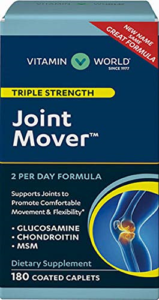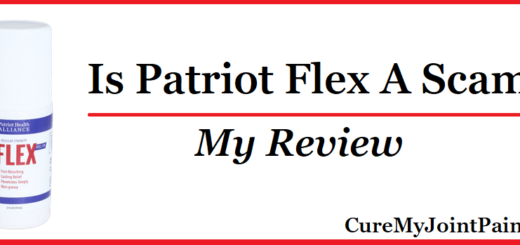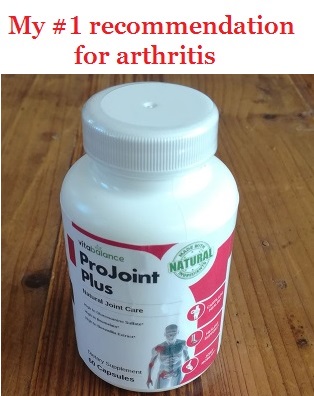My Joint Soother Review – Can It Really Help?

It’s time for my Joint Soother review – a joint product that doesn’t look amazing to me:
- uses the weaker form of glucosamine
- doses are not clearly mentioned
Besides, I’ve tried similar formulas in the past – without much success.
So is Joint Soother any good? Or it’s another supplement that promises a lot and does nothing? I tried it out myself so I can speak from experience.
Note: This review is based on my experience with Joint Soother, so it doesn’t contain just general info. I’m not trying to praise/criticize this product or its company, I am simply telling my opinion about it.
So Let’s Get To The Review
Full Name: Joint Soother Triple Strength from Vitamin World.
 Sizes: There’s are 4 main versions:
Sizes: There’s are 4 main versions:
- 60 or 90 caplets – the medium sizes
- 120 or 180 caplets – larger sizes
Best Actual Price: Around $22 (depending on the size and where you get it from).
Where I Bought It From: Ebay, because you can find all sizes there.
It’s also available on Amazon, but I could only find the 180 caplets version.
Designed For: Judging after the ingredients – osteoarthritis or cartilage problems:
- contains ingredients that rebuild cartilages
- small doses of anti-inflammatory
- couldn’t help the pain caused by inflammation (like in rheumatoid or psoriatic arthritis)
My Rating: 6 out of 10 – I only rated it so high because of the price.
Worth Buying?: Probably not, even though it’s pretty cheap:
- has the weaker form of glucosamine
- it doesn’t mention the doses for all ingredients
- it didn’t help me tremendously
So I personally would not recommend it – at least not for a regular form of OA. If you have minor issues, it should do its job.
What I Liked About It
- Pretty good choice of ingredients overall
- High dose of glucosamine
- You can find it in several sizes (I found 4, but there could be some others)
- Not very expensive
- You only have to take 2 pills per day
What I Didn’t Like About It
- Weak form of glucosamine (the HCl instead of the sulfate)
- Doesn’t mention some doses – I will explain below
- Didn’t improve my joints too much
- Pills are pretty thick and hard to swallow
Joint Soother – A Quick Overview
Well – Joint Soother looks like a classic supplement:
- contains well-established ingredients
- is produced by a well reputed company
- available in several retailers
- you can buy it both online and offline
So what makes it better then? Why would you buy this product – when there are over 100 similar ones?
It’s probably the price. Compared to others, Joint Soother is significantly cheaper.
However – that usually means it has a lower quality. So let’s dig deeper into it – starting with the ingredients.
The Ingredients – Not What I Expected
At first sight – Joint Soother’s ingredients looks pretty good:
- Classic substances
- Pretty high doses

But if you take a closer look – they’re not that impressive anymore. So let’s take them by turn:
1. Glucosamine Hydrochloride (1500 mg) – normally, glucosamine is the best ingredient for osteoarthritis:
- it rebuilds damaged cartilages
- also protects against further damage
However – I don’t like the form Joint Soother uses:
- the hydrochloride is pretty weaker overall
- it doesn’t have positive reviews in studies
- it’s only cheaper as a substance
1500 may be a great dose – but as it’s the HCl form, I doubt it’s going to be very effective. So that’s the #1 problem.
2. Mobili-Flex Proprietary Blend (1.194 mg) – this is a brand mix that is made of:
- MSM, Chondroitin, Collagen, Boswellia, Citrus Complex
- overall, it contains really good substances inside
- the final dose is pretty high
However – what bothers me is that there’s no dose for each particular ingredient.
This is a big problem – considering that most of those 5 ingredients are really essential (MSM, Chondroitin, Collagen).
4 Conclusions On The Ingredients
#1. Weak Form Of Glucosamine – as I said, this is the #1 problem of Joint Soother, in my opinion.
Basically – there are 2 forms of glucosamine: the sulfate and the HCl:
- there are lots of studies on the sulfate
- it has mostly positive results, while the result for the HCl aren’t that promising
- glucosamine HCl is cheaper as a lone substances
- most people have no idea about the difference
So that’s why many brands use the HCl form:
- It’s cheaper for them.
- Most people can’t tell the difference on paper.
But when it comes to results – the sulfate works much better overall. I always had much better results with it – compare to the HCl form.
#2. Good Dose – however, the dose of glucosamine is pretty good:
- 1500 mg is a great dose
- the HCl form is usually more pure than the sulfate (but it’s not better)
So speaking exclusively about the dose of glucosamine – Joint Soother looks pretty good.
#3. No Doses For The Blend – that’s the second problem I found about it:
- Only mentions the overall concentration of the proprietary mix
- There’s no exact dose for the Chondroitin, Boswellia or the rest
In most cases – companies do this in order to hide some small doses.
Considering there’s about 1200 mg overall:
- that would mean about 250 mg/substance
- this is a pretty low dose
#4. Better For Cartilage Problems – judging after what it contains, Joint Soother should work better for OA:
- glucosamine, chondroitin, collagen, MSM help cartilages
- only Boswellia is an anti-inflammatory
- however, it probably has a low dose
So I wouldn’t recommend this product for joint pain caused by inflammation.
My Experience With Joint Soother
#1. Why I Tried It – the main reason was for my OA:
- it was affecting both of my knees
- it was a consequence of cartilage tear – due to my rheumatoid arthritis
- the pain wasn’t that bad (a 3-4)
- the #1 problem was that I lost my knee flexibility
- so walking and standing was more difficult than it used to be
 #2. How It Worked – to be honest, Joint Soother didn’t work amazingly for me.
#2. How It Worked – to be honest, Joint Soother didn’t work amazingly for me.
I could see a difference after using it – but it wasn’t any better than most glucosamine products. Here’s what I mean:
- My pain did get better after about 2 weeks
- It went from a 4 to about a 2 – so it didn’t disappear completely
- My knees felt a bit better after about 2 months
- However, the improvement was pretty small
Actually – I wasn’t getting so tired after walking around the home. That was mostly the improvement.
- But I still couldn’t bend down or bend my knees
- Also – I couldn’t stand for more than 20-30 minutes
#3. Overall – I can’t tell Joint Soother worked too well. Most supplements I tried also helped with these things.
In my opinion, it’s because of the weak form of glucosamine it uses. But obviously – I can’t tell for sure.
So I wouldn’t really recommend Joint Soother for joint problems or osteoarthritis. There are many products that are way better, in my view.
Now let’s take a quick look at the best and the worst things about Joint Soother.
#1 Advantage – Quality Ingredients
To be honest, Joint Soother contains some really good stuff inside. At least at first sight.

So here’s the thing:
- most ingredients are classic substances
- overall – they have many studies on joint pain with positive results
- I can also confirm that they’re very effective (based on personal experience)
So there’s only that weak form of glucosamine that I really don’t like.
All the other ingredients look very promising:
- Chondroitin and MSM exist in most joint supplements.
- Collagen is also a quality substance.
- Boswellia is often times associated with turmeric – for inflammation.
- Citrus Complex is the only one that’s not so popular – but it also works for inflammation.
Compared to other joint supplements, Joint Soother really contains good substances inside. So that’s a real advantage.
#2 Advantage – Great Price
To be honest, Joint Soother is definitely not expensive. Compared to similar products – it’s actually quite cheap.
Let’s take the 120 pills version:
- it’s enough for 2 months
- the price is around $22 per bottle
- this means you only pay around $11 per month – which is super cheap
Now – there is indeed a problem. I couldn’t find all the versions on Amazon (and they usually have the best price here).
So I couldn’t tell the exact price for each size – because they are different on most retailers.
However – one thing is clear:
- it’s really cheap for what it has inside
- doesn’t cost as much as similar supplements
- it only depends where you buy it from
So if you decide on Joint Soother (though I personally don’t recommend it) – make sure you check out several shops before making the actual purchase.
#1 Problem – Concentrations
Now – the major problem of Joint Soother is probably the glucosamine HCl.
 But as I already explained why it’s a problem for me – I won’t mention it again.
But as I already explained why it’s a problem for me – I won’t mention it again.
However, another big downside of Joint Soother are its doses (or their lack):
- Only the concentration of glucosamine HCl is mentioned
- For the other ingredient – it’s only mentioned the final dose
So here’s what the label should look like – in my opinion:
- the ingredients are fine
- the Proprietary Blend’s dose is also fine
- but each of the 5 ingredients inside should be mentioned separately
- they should also mention the dose for each
That would mean: A mg of chondroitin, B mg of MSM, C mg of collagen – and so on.
In this way, you could know exactly what you’re taking. But as it is now – the doses are probably small for some of those ingredients.
So in my opinion – that’s why they’re not showing them clearly.
I’ve seen many companies doing this when their doses are too low – so that’s why I believe this.
#2 Problem -Not Too Helpful
Honestly – Joint Soother didn’t convince me it’s a worth buying supplement:
- it didn’t relieve my knee pain completely
- didn’t improve my flexibility too much
- overall – it wasn’t better than most products
Now – I’m mostly speaking from experience, but I can’t consider it a really good product.

So here’s the thing:
- It couldn’t help someone with inflammation problems (low doses of anti-inflammatory)
- It can decrease OA pain
- But I doubt it could improve flexibility or rebuild cartilages
As I said – that’s my personal opinion, judging after how it worked for me.
So I wasn’t too satisfied overall – it’s not such a helpful supplement as you might think.
#3 Problem – Large Pills
That’s another thing I didn’t really like about Joint Soother:
- pills are pretty thick and big
- swallowing them isn’t too easy
Now – I know that glucosamine pills tend to be thicker.
But I’ve seen many supplements with decent pills in terms of size.
Plus – Joint Soother mentions that its pills are caplets, not capsules or tablets. So what does that mean?
- normally, caplets are smaller in size
- they are also lighter – not as thick as capsules
So I personally wish they were a bit smaller – since you have to take 2 per day.
Obviously, it’s not the biggest problem ever – but in terms of comfort, it’s not too good.
My Verdict – Is Joint Soother Worth Buying?
Short answer: Probably not. I would only recommend it in this case:
- you have an easy form of osteoarthritis
- you want to test out a cheap product, in case it helps
Otherwise – it’s surely not the kind of supplement I would recommend:
- Contains the weaker form of glucosamine (HCl)
- Doesn’t mention most of the doses
- Didn’t help my joints too much
Now, I admit it’s a really cheap supplement – so you wouldn’t be wasting a lot of money anyway.
But I think it’s not the right choice for osteoarthritis – considering the reasons I mentioned above.
So I personally would choose something else, even if it’s a few dollars more. But obviously, it’s all up to you.






